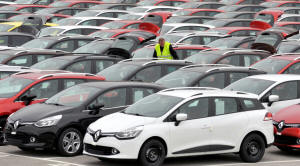Energy crisis could cut Europe's car output nearly 40% - S&P Global
Mobility
 Send a link to a friend
Send a link to a friend
 [October 11, 2022] By
Nick Carey [October 11, 2022] By
Nick Carey
LONDON (Reuters) - Auto forecaster S&P
Global Mobility warned on Tuesday that, under a worst case scenario,
Europe's energy crisis could cut its car production by close to 40%, or
more than 1 million vehicles, per quarter through the end of 2023.
In a report titled 'Winter is Coming,' S&P Global Mobility said the auto
industry's supply chain - already reeling from the COVID-19 pandemic and
Russia's invasion of Ukraine - "may face extensive pressure" from
soaring energy costs or even power cuts.
"With energy prices in Europe skyrocketing... a harsh winter could place
certain automotive sectors at risk of being unable to keep their
production lines running," the report said.
S&P Global Mobility said costs had already escalated for car production,
to between 687 euros ($667) and 773 euros per vehicle, up from a
pre-energy crisis level of 50 euros, putting strain on smaller suppliers
in particular.

Starting this quarter through the end of 2023, S&P Global Mobility had
forecast quarterly production from European car assembly plants would be
between 4 million and 4.5-million units.
But "with potential utility restrictions" that could be cut to as little
as 2.75 million to 3 million units per quarter.
The auto forecaster warned that because European suppliers export parts
around the world, all carmakers would be impacted in some way.
[to top of second column] |

Renault cars produced in Turkey and
awaiting export throughout Europe, are checked by a worker in the
port of Koper October 14, 2013. REUTERS/Srdjan Zivulovic/File Photo

Edwin Pope, S&P Global Mobility principal analyst for materials and
lightweighting, told Reuters the analysis was conducted before the
likely sabotage of the Nord Stream pipelines late last month.
"Events like that will inevitably shift the scales towards the lower
end of what we have predicted, especially in terms of how long it
takes to repair things of this nature," Pope said.
For individual countries across Europe, the auto forecaster looked
at six factors including the size of a country's deficit, debt
relative to gross domestic product, level of energy self-sufficiency
and gas storage.
While automotive powerhouse Germany has relied on Russian gas and is
phasing out nuclear power, it has "more budgetary headroom to ride
out the energy storm" than some other European countries including
Italy, it said.
Pope said while the auto industry might be able to struggle through
this winter, if Europe did not have a plan in place for the
following winter then many suppliers might not survive.
"I'm worried we'll have some highly-skilled craftsman shops in the
region either go through forced bankruptcy or just hang up their
hats," Pope said.
($1 = 1.0303 euros)
(Reporting by Nick Carey; Editing by Mark Potter)
[© 2022 Thomson Reuters. All rights
reserved.]
This material may not be published,
broadcast, rewritten or redistributed.
Thompson Reuters is solely responsible for this content. |